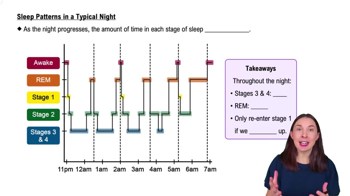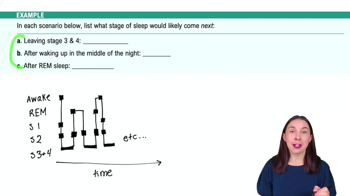Table of contents
- 1. Introduction to Psychology1h 43m
- 2. Psychology Research2h 20m
- 3. Biological Psychology2h 41m
- 4. Sensation and Perception28m
- 5. Consciousness and Sleep32m
- 6. Learning41m
- 7. Memory34m
- 8. Cognition37m
- 9. Emotion and Motivation35m
- 10. Developmental Psychology33m
- 11. Personality48m
- 12. Social Psychology41m
- 13. Stress and Health41m
- 14. Psychological Disorders44m
- 15. Treatment47m
5. Consciousness and Sleep
Sleep
Struggling with Psychology?
Join thousands of students who trust us to help them ace their exams!Watch the first videoMultiple Choice
An example of a biological rhythm is
A
a state of increased alertness.
B
hunger.
C
the beat of the heart.
D
dreaming.
 Verified step by step guidance
Verified step by step guidance1
Understand the concept of biological rhythms: Biological rhythms are natural cycles of change in our body's chemicals or functions. They are driven by internal biological clocks.
Identify different types of biological rhythms: These include circadian rhythms (24-hour cycles like the sleep-wake cycle), ultradian rhythms (shorter than a day, like the stages of sleep), and infradian rhythms (longer than a day, like the menstrual cycle).
Consider the options given: Increased alertness, hunger, the beat of the heart, and dreaming.
Analyze each option: Increased alertness and hunger are influenced by circadian rhythms but are not rhythms themselves. Dreaming is part of the sleep cycle, an ultradian rhythm. The beat of the heart is a continuous, rhythmic biological process.
Conclude which option is a biological rhythm: The beat of the heart is a consistent, rhythmic biological process, making it an example of a biological rhythm.

 3:25m
3:25mWatch next
Master Circadian Rhythms with a bite sized video explanation from Hannah Gordils
Start learningRelated Videos
Related Practice


































































































![Race, Genes and IQ Differences | Bret Weinstein [Mini Clip]](https://img.youtube.com/vi/IztL_m3pd70/mqdefault.jpg)



































































































